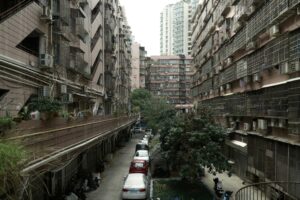Social Capital In Recently Restructured Urban Neighbourhoods In Dutch Cities
Introduction:
In two recently restructured urban neighbourhoods in the city of Rotterdam, we study residents’ social capital. Herewith, we distinguish between the stayers, movers and newcomers. In a neighborhood context, social capital refers to the benefit of cursory interactions, shared norms, trust, and collective action of residents. Survey data show that social capital is not only an asset of long-term stayers but that in particular newcomers are relatively rich in social capital. Factors associated with higher levels of social capital are a higher net income, presence of households with children, stronger place attachment, higher perceived neighborhood quality, homeownership and single-family dwellings. The expected future length of residence in the area appears of little importance for social capital.

Restructured Urban Neighbourhood Dynamics and Social Mix:
In many Dutch cities, early post-war neighbourhoods are subject to considerable interventions. Low-cost social rented apartments often dominate the housing stock in these areas. Mainly low-income households with limited options rent these houses. Middle-class and higher-income households lack attractive housing career opportunities in these neighbourhoods and often leave them. In 1997, the Dutch government launched an ambitious restructuring urban neighbourhoods program to tackle the problems of urban post-war districts. Demolition, sale or upgrading of social rented housing and new construction of more expensive owner-occupied housing should create much more variety in the housing stock. The neighbourhood layout, public space, services and infrastructure are improved simultaneously. In the coming decade, tens of thousands of households are directly affected.
– Stayers who remain living in the same dwellings in the restructured urban neighbourhoods.
It is quite common that only part of the neighbourhood is demolished. In the other parts, restructuring measures did not require the stayers to move. Either their houses were subject to limited renovation or to no physical measure at all. Thus, many have a (far) longer length of residence in the restructured urban neighbourhood than other resident categories.
– Movers within restructured urban neighbourhoods to untouched, renovated, or newly constructed houses.
This group also includes residents who experienced forced relocation from demolished dwellings within the same neighbourhood.
– Movers from surrounding neighbourhoods.
This category includes all movers from adjacent neighbourhoods to the restructured area. A common finding in housing research is that many moves cover short distances
– Newcomers are new residents from anywhere outside the restructured area and its surrounding neighbourhoods.
The newcomers mainly moved to the newly constructed houses, but also to the original or the renovated houses.
– Forced movers out of restructured urban neighbourhood.
Residents who are forced to move to a different neighbourhood, due to demolition or upgrading of their dwelling. The issue of forced relocation is beyond the scope of this paper, because our focus is on social capital in recently restructured urban neighbourhoods. However, the issue is studied in depth in other papers.
Social Capital in Neighbourhoods:
Because social capital and weak ties are basically network concepts, studying social capital in neighbourhoods poses several problems. Most important is that neighbourhoods and networks are completely different entities that almost never converge. ‘Neighbourhood’ is a socio-spatial or imagined unit with a specific, but a limited social significance for its residents. It is only one of the many contexts in which people establish and maintain their social networks. Thus, neighbours and other residents usually form just a small part of residents’ social networks.
Conclusion:
This paper has focused on the social capital of four different resident categories in Dutch restructured urban neighbourhoods. Within this context, we have defined social capital as the benefit of cursory interactions, shared norms, trust and collective action of residents. In our two restructured urban neighbourhoods, social capital is hardly an asset on neighbourhood level, but usually appears on much lower spatial scales: in building blocks, streets, parks, playgrounds and over garden fences. Survey research among substantial numbers of residents enabled us to study social capital levels of the stayers, the movers within the neighbourhood, the movers from surrounding neighbourhoods and, finally, the newcomers.
